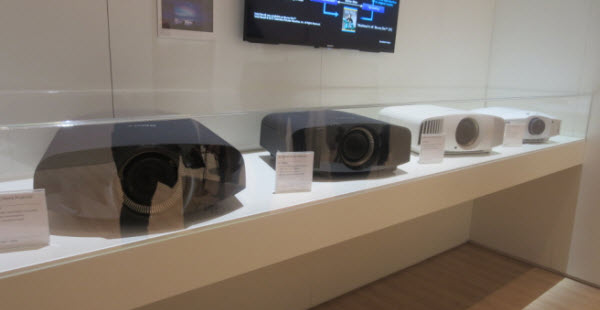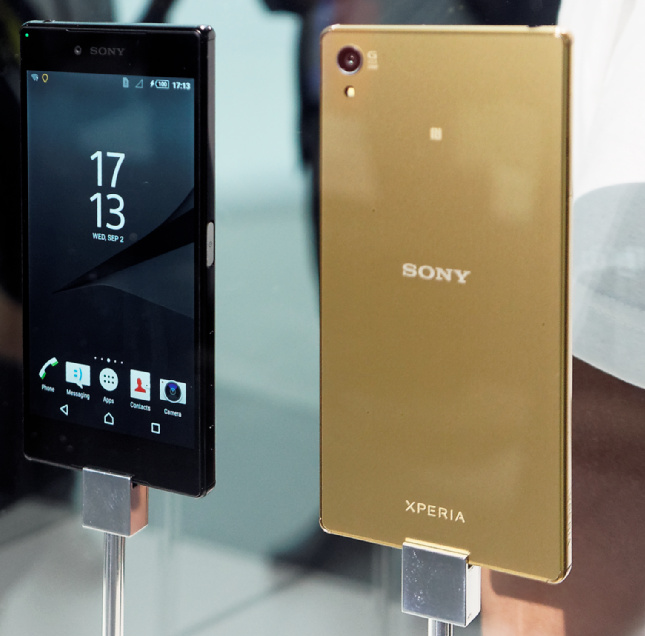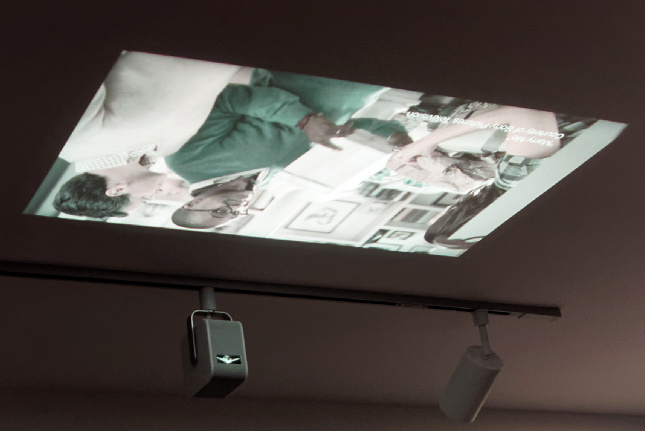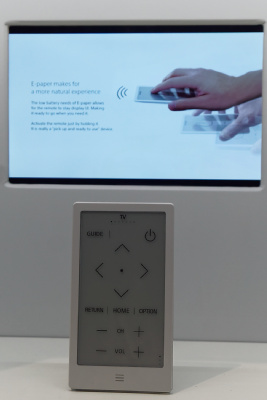Although the big news to come from Sony at IFA was about a small product – the world’s first UltraHD smartphone (we’ll get to that later) – we began our tour in the projector area. Here, Sony had unveiled two DCI-4k models for the home, as well as high-quality Full HD unit.
 The VPL-VW520ES and VPL-VW320ES are successors to the VPL-VW500ES and VPL-VW300ES. These are some of the only home cinema projectors that go beyond UltraHD, but that has not added significantly to the price: they will be available for €8,400 and €5,900, respectively. Why does the VW520ES cost more? Because it also supports HDR content through HDMI – so far, Sony’s only projector to do so.
The VPL-VW520ES and VPL-VW320ES are successors to the VPL-VW500ES and VPL-VW300ES. These are some of the only home cinema projectors that go beyond UltraHD, but that has not added significantly to the price: they will be available for €8,400 and €5,900, respectively. Why does the VW520ES cost more? Because it also supports HDR content through HDMI – so far, Sony’s only projector to do so.
Sony’s colour-enhancing Triluminos technology and Motionflow frame rate enhancement are built in to the projectors. They can show DCI-4k content at 60fps, using 4:2:0 colour subsampling. A colour correction tool can be used to adjust the hue, and brightness and saturation for each RGB colour. Brightness is 1,800 lumens on the VW520ES and 1,500 lumens on the VW320ES.
I had the chance to see a demonstration of the VW520ES in action, which naturally – using content that was chosen to highlight the resolution and dynamic range – looked stunning. I had thought that seeing individual strands of hair was impressive, but this model even shows the veins in an actor’s eye! I asked whether Sony was concerned about the lack of HDR content, but apparently the company is not concerned. The inclusion of the technology in the UltraHD Blu-ray specification means that more will arrive quickly, said product planner Yoshi Koike. Several studios are also looking at ways to regrade existing content to add HDR.
The HW65ES is Sony’s Full HD projector. Like the others, it uses an SXRD imager – Sony’s variant on LCoS – and a new lamp driving scheme, which has extended lamp life to 6,000 hours. Brightness is 1,800 lumens, and the unit can be controlled via IP.
 Sony’s Xperia Z5 Premium has an UltraHD displayThe Z5 is Sony’s new smartphone, available in three models: Z5 Compact (4.6″, 1280 x 720), Z5 (5.2″, 1920 x 1080) and Z5 Premium (5.5″, UltraHD). Like other Xperia smartphones, these models are waterproof.
Sony’s Xperia Z5 Premium has an UltraHD displayThe Z5 is Sony’s new smartphone, available in three models: Z5 Compact (4.6″, 1280 x 720), Z5 (5.2″, 1920 x 1080) and Z5 Premium (5.5″, UltraHD). Like other Xperia smartphones, these models are waterproof.
A new feature is the use of Sony’s new camera technology in the Z5 and Z5 Premium, with a 23MP Exmor RS sensor. The sensor enables an autofocus speed of 0.037 seconds – faster than a human blink – as well as low-light shots. Also new is a fingerprint sensor on the power button, which will be used for biometric security in online payments.
All three new phones use Qualcomm’s Snapdragon 810 processor, and a two-day battery life is claimed. They are capable of fast charging, to 5.5 hours of battery on 10 minutes of charge.
As well as the above features, Sony has built multiple premium display enhancements into the Z5 Premium. These include Triluminos technology, X-Reality for Mobile processing, UltraHD upscaling and a version of HDR called Dynamic Contrast Enhancer. All of these features should add up to a significant drain on the 3,430mAh battery. However, Sony sticks to the two-day claim. One of the technologies enabling this is ‘memory on display’, optimising the data transfer between processor and device. The Z5 Premium’s display memory ‘memorises’ an image so that the full image does not need to be reloaded each time it is viewed – even in a video.
Sony’s Xperia Z5 Compact and Z5 will be available in October, followed by the Z5 Premium in November.
We saw two new TVs on the stand, although they were simply different sizes of existing ranges: the 75″ X9105C (X910C in the USA) and 65″ S8505C (S850C in the USA). These TV sizes were mentioned at CES earlier this year. We also heard that several TV ranges would receive HDR compatibility via a software update this year: the X910C, X90C, X85C and S85C.
Sony was also demonstrating its Smart Eyewear (AR glasses) and Morpheus VR headset. The AR glasses are still a prototype, although Morpheus is confirmed as a product that will be launched at some point in the future.
All prices are ex VAT.
 Sony’s UST portable projector is a prototypeOne part of the booth was sectioned off and was being used to show some of Sony’s LightSpace products. The main product on demonstration was a new one – due in Spring 2016 and, therefore, with few details available: an ultra-short-throw projector that runs on batteries. The unit was being shown in a variety of applications: as a kids’ room games projector, as a display for movies “on the balcony”, as a projector of movies onto the ceiling above a bed and as an addition to a pinboard for family management. The unit could also be used for projecting images onto a dining table to keep children amused, or as an additional display on a home office desk. We asked about resolution, brightness, imager type etc etc, but no details are finalised. The unit will run on battery or mains and rated for 20″ to 50″ images (although bigger ones are possible at very low brightness).
Sony’s UST portable projector is a prototypeOne part of the booth was sectioned off and was being used to show some of Sony’s LightSpace products. The main product on demonstration was a new one – due in Spring 2016 and, therefore, with few details available: an ultra-short-throw projector that runs on batteries. The unit was being shown in a variety of applications: as a kids’ room games projector, as a display for movies “on the balcony”, as a projector of movies onto the ceiling above a bed and as an addition to a pinboard for family management. The unit could also be used for projecting images onto a dining table to keep children amused, or as an additional display on a home office desk. We asked about resolution, brightness, imager type etc etc, but no details are finalised. The unit will run on battery or mains and rated for 20″ to 50″ images (although bigger ones are possible at very low brightness).
(Separately, Sony US announced a pico projector, but it is quite a lot smaller than the one shown at IFA Sony Announces MP-CL1 Pico Mobile Projector)
As well as this product, Sony demonstrated a bulb that includes a loudspeaker so that it can play back music (via Bluetooth) from a mobile and a “speaker lamp” that uses the glass of the lamp as the surface of the speaker.
Under the Seed Acceleration programme that Hirai talked about in the press conference were a new Huis remote control that uses a touch-enabled E Ink display as a configurable touch service for the control. Another project is the Wena watch band – a unit that has smart functions, but can be used as the strap for a traditional watch. The device gives alerts and does some fitness tracking as well as acting as an eWallet.
 Sony huis remote uses an E Ink display
Sony huis remote uses an E Ink display
Analyst Comment
These new smartphones will help Sony in its goal of improving profitability over shipment volumes; margins are wider at the high end of the market. However, it is hard to see how the UltraHD display – although an impressive marketing claim – will help Sony to sell units. Not only is there (still) a lack of content (UltraHD content will not initially be available on Netflix’s mobile app), but it will be hard to see the difference between the standard Z5 and the Z5 Premium at these screen sizes.
We also believe that the Z5 will be negatively affected by the need to use Qualcomm’s Snapdragon 810, which has been blamed for overheating in several smartphones. As Ian Fogg of IHS points out, LG experienced these problems in its Flex 2, and switched to the older Snapdragon 808 in the G4. (TA)

